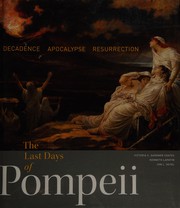Check nearby libraries
Buy this book

Destroyed yet paradoxically preserved by the eruption of Mount Vesuvius in A.D. 79, Pompeii and other nearby sites are usually considered places where we can most directly experience the daily lives of ancient Romans. Rather than present these sites as windows to the past, however, the authors of this book exlore Pompeii as a modern obsession, in which the Vesuvian sites function as mirrors of the present. Through cultural appropriation and projection, outstanding visual and literary artists of the last three centuries have made the ancient catastrophe their own, expressing contemporary concerns in diverse media, from paintings, prints, and sculpture, to theatrical performances, photography, and film. This volume, featuring the works of artists such as Piranesi, Fragonard, Kaufmann, Ingres, Chasseriau, and Alma-Tadema, as well as Duchamp, Dali, Rothko, Rauschenberg, and Warhol, surveys the legacy of Pompeii in the modern imagination under the three overarching rubrics of decadence, apocalypse, and resurrection. The section on decadence investigates the perception of Pompeii as a site of impending and well-deserved doom due to the excesses of the ancient Romans, such as paganism, licentiousness, greed, gluttony, and violence. The catastrophic demise of the Vesuvian sites has become inexorably linked with the understanding of antiquity, turning Pompeii into a fundamental allegory for apocalypse, to which all subsequent disasters (natural or man-made) are related, from the San Francisco earthquake of 1906 to Hiroshima, Nagasaki, 9/11, and Hurricane Katrina. The section on resurrection examines how Pompeii and the Vesuvian cities have been reincarnated in modern guise through both scientific archaeology and fantasy, as each successive cultural reality superimposed its values and ideas on the distant past.
Check nearby libraries
Buy this book

Previews available in: English
Showing 1 featured edition. View all 1 editions?
| Edition | Availability |
|---|---|
|
1
The last days of Pompeii: decadence, apocalypse, resurrection
2012, J. Paul Getty Museum
in English
1606061151 9781606061152
|
aaaa
Libraries near you:
WorldCat
|
Book Details
Edition Notes
This publication is issued on the occasion of the exhibition The Last Days of Pompeii: Decadence, Apocalypse, Resurrection, on view at the J. Paul Getty Museum at the Getty Villa in Malibu, from September 12, 2012, to January 7, 2013; at the Cleveland Museum of Art from February 24 to May 19, 2013; and at the Musée national des beaux-arts du Québec from June 13 to November 8, 2013.
Includes bibliographical references and index.
Classifications
The Physical Object
ID Numbers
Community Reviews (0)
Feedback?| August 25, 2024 | Edited by MARC Bot | import existing book |
| November 10, 2021 | Edited by ImportBot | import existing book |
| August 3, 2020 | Edited by ImportBot | import existing book |
| February 28, 2020 | Edited by MARC Bot | remove fake subjects |
| March 28, 2012 | Created by LC Bot | import new book |









